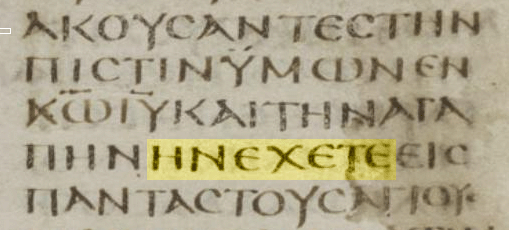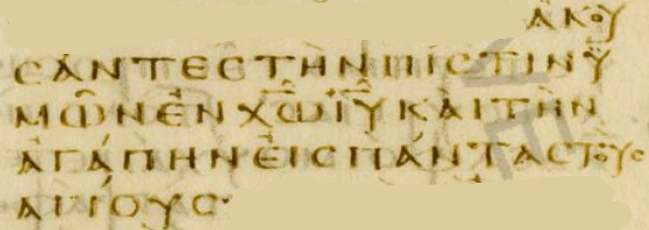
|
Return to Previous Editions page | ||
| Edition 15 | KJV Clarification was Nothing New | 9/29/19 | |
|
|
|||
|
As the Apostle Paul begins his letter to the Colossians, he expresses his thankfulness to God for their faithfulness and love. Col. 1:4 is a part of the passage: (KJV) "Since we heard of your faith in Christ Jesus, and of the love which ye have to all the saints," (NASV) "since we heard of your faith in Christ Jesus and the love which you have for all the saints;" A bit of the vocabulary is updated in the NASV, but the two versions are identical. The point of interest is the italicized phrase "which ye have" (KJV). The words were added by the translators; they are not in the source text (textus receptus). The TR reads: ακουσαντες την πιστιν υμων εν χριστω ιησου και την αγαπην την εις παντας τους αγιους Byzantine manuscript sources for the TR are identical. They read: ἀκούσαντες τὴν πίστιν ὑμῶν ἐν χριστῷ Ἰησοῦ, καὶ τὴν ἀγάπην τὴν εἰς πάντας τοὺς ἁγίους, The clarification (italicized in the KJV) is conventional and well-founded since the thought is clearly implied in the text. As indicated, the NASV contains the same words ("which you have"), but they are NOT in italics. The reason is that the source text for the verse (GNT, or greek new testament) actually includes the phrase. Here's what it says: ἀκούσαντες τὴν πίστιν ὑμῶν ἐν Χριστῷ Ἰησοῦ καὶ τὴν ἀγάπην ἣν ἔχετε εἰς πάντας τοὺς ἁγίους |
One of the GNT's two major manuscript sources, Codex Sinaiticus, includes the phrase ἣν ἔχετε, which translates directly to "which you have". The words were probably not in the original. Otherwise, we must infer that they were deleted by someone while making a copy. Considering the nature of the phrase, that seems unlikely. In the copying sequence leading to the Sinaiticus, a scribe may have added it for the same reason the KJV translators did, more than a thousand years later. Without knowing it, the seventeenth century scholars followed a manuscript source that was six or seven hundred years older than anything they had. It's possible no one seriously considered the words original until Sinaiticus was discovered in the late 1800's, nearly 300 years after the the KJV was first published in 1611.
|
|||
|
|
||||
 This image of Col. 1:4 is from codexsinaiticus.org, a site representing "The
Codex Sinaiticus Project". The phrase "
This image of Col. 1:4 is from codexsinaiticus.org, a site representing "The
Codex Sinaiticus Project". The phrase " Here's another image of the verse. It's from a Vatican Library website which presents
the Codex Vaticanus, the other major manuscript source for the GNT. Note that, like the Byzantine sources
for the KJV, it does not include the phrase.
Here's another image of the verse. It's from a Vatican Library website which presents
the Codex Vaticanus, the other major manuscript source for the GNT. Note that, like the Byzantine sources
for the KJV, it does not include the phrase.